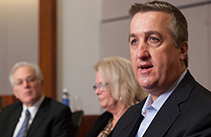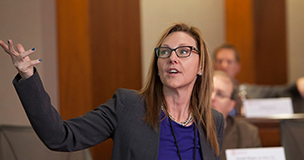Agenda
Virtual classroom | Sept. 25 – Oct. 28
Note: All virtual session times are EST.
Thursday, Sept. 25
3 – 5 p.m.
Influencing policy and politics in an uncertain landscape
Cristina Freyre Batt, Senior Vice President, Federal Policy, HANYS
Bea Grause, RN, JD, FACHE, President, HANYS
Amy Nickson, Senior Vice President, State Policy, HANYS
The COVID-19 pandemic placed extraordinary stress on healthcare systems. Five years later, New York’s hospitals remain in crisis. They face a national healthcare worker shortage, unprecedented expense increases, fewer places to safely discharge patients, stagnant infrastructure, market changes that leave hospitals increasingly serving only the sickest and most vulnerable patients, and political uncertainty at the federal and state levels.
With just over half of New Yorkers covered by Medicare or Medicaid, state and federal policymakers play an outsized role in how patients receive care and how providers are reimbursed. Health plan behavior, an aging population, multi-generational consumer demands and cost pressures continue to rapidly shift how and where healthcare is delivered.
This session offers context and perspectives on the forces shaping our dynamic healthcare landscape and helps healthcare executives assess and understand the political environment and how it impacts care delivery in their communities.
Tuesday, Sept. 30
3 – 5 p.m.
Value-based care: Over a decade of experience and where the industry is moving next
Victoria Aufiero, Vice President, Insurance, Managed Care and Behavioral Health, HANYS
Alyssa Dahl, Vice President, Advanced Analytics, DataGen®, Inc.
Cara Henley, Managing Principal, Health Management Associates
This session will cover alternative payment models and their impact on care delivery and coverage design. Faculty will explore the different types of value-based payment models, including the risks and benefits of entering these new payment arrangements. This session will highlight the most important value-based care concepts to know, lessons learned after a decade of models tested, and new initiatives at the federal and state level, including New York’s 1115 Waiver.
Tuesday, Oct. 7
3:30 – 5 p.m.
Quality and patient safety in a dynamic healthcare environment
Colleen McVeigh, Principal Healthcare Informatics Analyst, HANYS
Kathleen Rauch, RN, MSHQS, BSN, CPHQ, Vice President, Quality Advocacy, Research and Innovation, HANYS
Patient care quality and cost, regardless of sector, are under close scrutiny at federal and state levels. Providers already face regulatory, reimbursement and reputational risks related to quality performance and may see additional penalties levied soon. To avoid these risks, healthcare leaders must understand the quality and patient safety reporting landscape and their current performance to ensure their organizational quality, patient safety and infection control plans address priority areas and are successful.
This session will teach you about quality reporting requirements, performance improvement and patient safety methods. We’ll also explore the practical application of these concepts, including best practices and how to analyze data effectively and accurately to maximize results.
Tuesday, Oct. 14
3 – 5 p.m.
What is your hospital market and how can you protect and expand it, compete and survive?
Jeff Gold, Esq., Special Counsel, Insurance and Managed Care, HANYS
Cara Henley, Managing Principal, Health Management Associates
Steven I. Goldstein, President, System Integration Strategy, UR Medicine
Hospital executives need to understand various market forces’ current and projected impact on their organization to effectively manage operations and plan for challenges and opportunities. As a leader, you must weigh factors such as regional characteristics, case and payer mixes, traditional and non-traditional competitors, potential partnerships with payers and other providers, and more. During this session, we’ll review such factors and strategies to help you ensure your organization effectively serves your mission and community while being set up to survive and thrive.
Tuesday, Oct. 21
3 – 5 p.m.
Building a technology strategy for today’s healthcare
Thomas Hallisey, Director, Digital Health Strategy, HANYS
A focused, comprehensive technology strategy is crucial for healthcare organizations. Technology impacts an organization’s ability to run efficient operations, provide quality care, enhance a limited workforce and meet demands in a competitive landscape. We’ll review the foundational tools available and emerging technologies, how technology is changing healthcare now and where it may lead us in the future. We’ll also explore practical considerations for strategic planning that incorporate the evolving technology available to help guide healthcare’s transformation.
Tuesday, Oct. 28
3 – 5 p.m.
Building talent pathways and pipelines
Karen A. Scott, MS, HRD, Director, Learning and Development, University of Rochester Medical Center
Stephanie Von Bacho, EdD, MS, RN, NEA-BC, Senior Director, Learning and Development, University of Rochester Medical Center
We are all feeling the impact of the current job market — the lingering effects of a global pandemic, ongoing staffing shortages and a competitive job marketplace offering creative incentives to attract talent. The days of simply posting a job opening and counting on applicants to fill vacant positions are a distant memory.
In this session, you’ll learn about the innovative “outside in, inside up” approach to workforce development, including strategic, intentional and collaborative efforts to not only attract and retain staff but build diverse talent pipelines that support your community. We will also discuss alignment with organizational strategies and techniques for enculturation.





